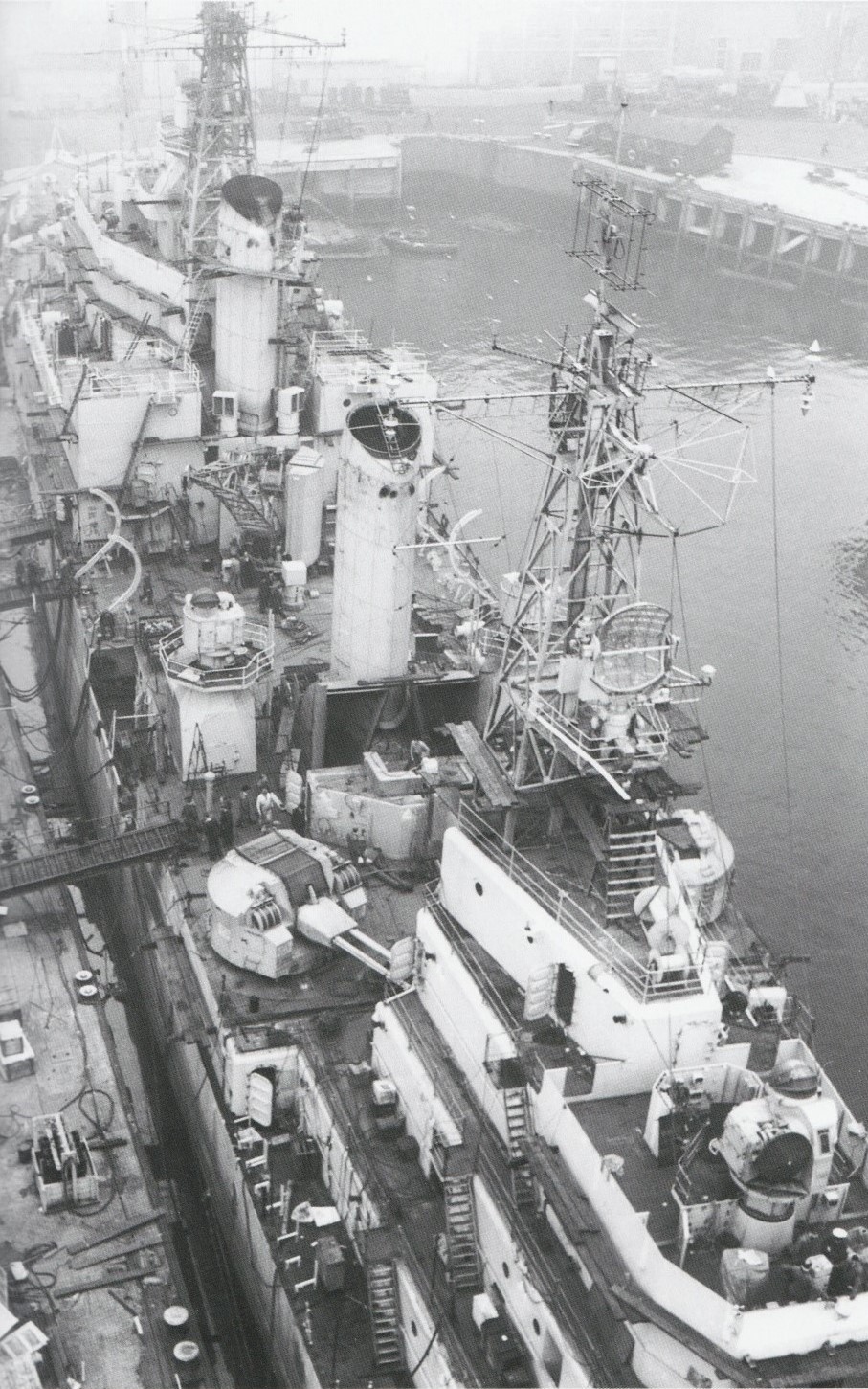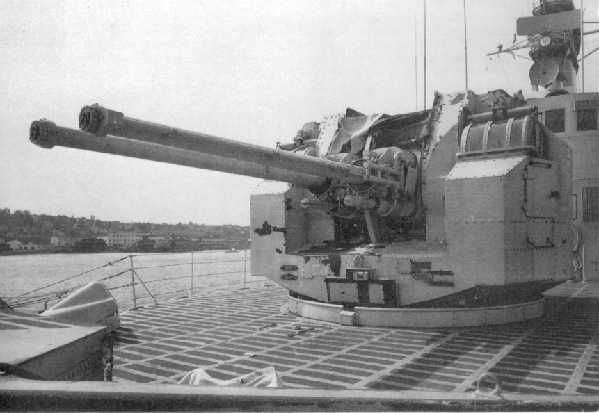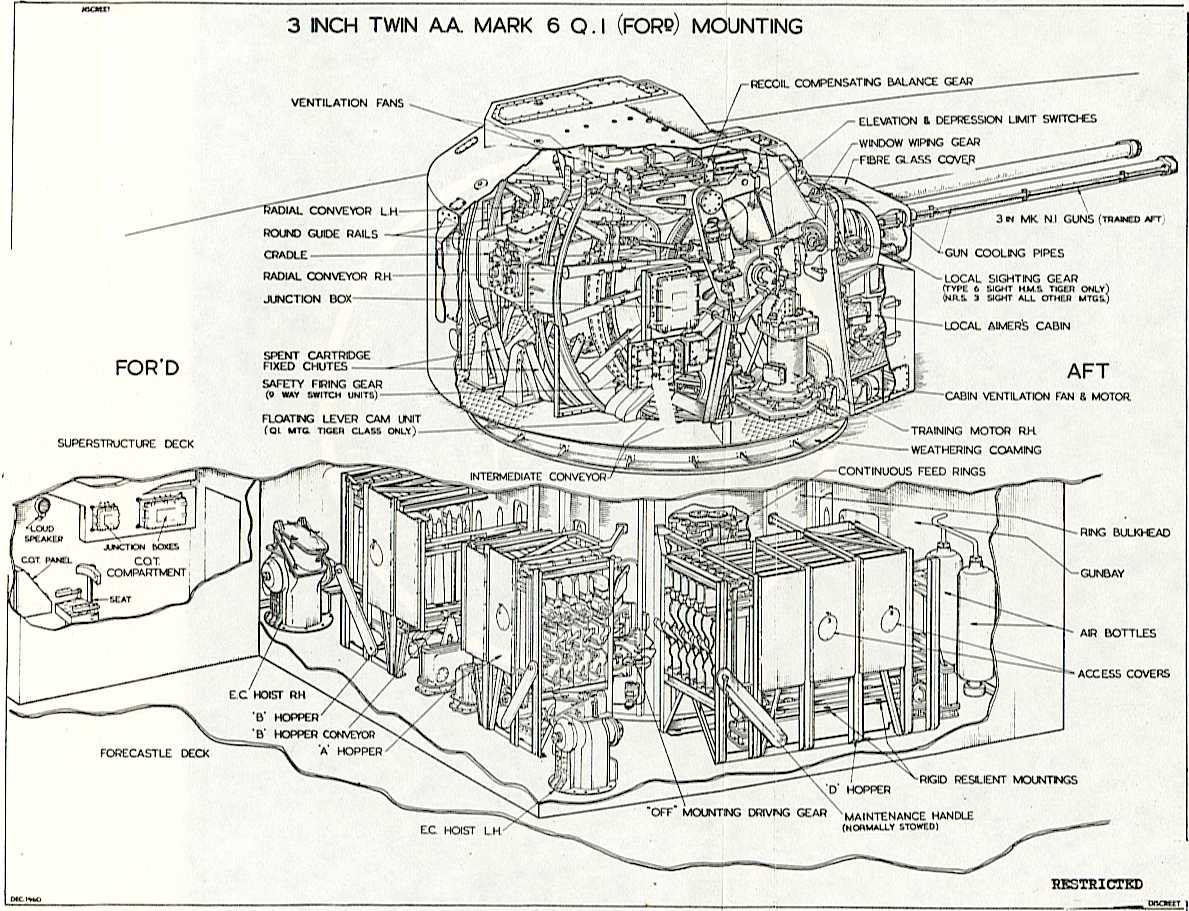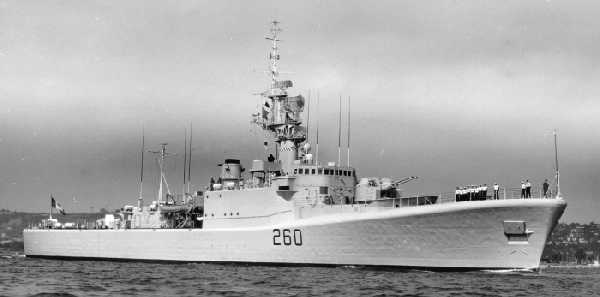This was an AA mounting designed by Vickers for the Tiger class cruisers and later used on Canadian destroyer escorts. It had been intended to arm British frigates of the 1950s with this weapon, but it was not ready in time and the 4.5" (11.4 cm) Mark 6 was used in its place.
The development of the ammunition and the gun barrel was a joint British-American project, but each navy chose to design a completely different gun mount. The British mounting was less ambitious in concept and slightly more successful in practice than its American counterpart, the 3"/70 (7.62 cm) Mark 37 mounting.
The British mounting was prone to ammunition feed breakdowns and required much maintenance to keep in service. During refits for ships based on the West Coast, components of the mounting would be removed from the ship and then shipped by rail from Esquimalt, British Columbia, to the Naval Armament Depot in Dartmouth, Nova Scotia, where they would be rebuilt and then shipped back to the West Coast. Later, Esquimalt became the primary center for maintaining these weapons.
The gun barrel was a water cooled monobloc type and used a vertically sliding breech mechanism. There is a three caliber smoothbore section near the muzzle (Probertised) to reduce loss of velocity and to act as a flash suppressor. The barrel is attached to the breech ring by interrupted threads (bayonet joint) and can be removed without dismounting the gun, similar to earlier USN designs.
The gun is designed such that the empty cartridge is ejected and the next round rammed while the gun is running out. The mounting has a local control cab on the right side of the mounting, visible in the photographs and sketch below.
Nomenclature note: Per the post-war designation system, "Mark 6" is actually the mounting designation. The gun itself was designated by the British as Ordnance QF 3in Mark N1. It is believed to have been identical to the US 3"/70 (7.62 cm) Mark 26.
| Designation | Weapon: 3"/70 (7.62 cm) QF Mark N1
Mounting: Mark 6 |
|---|---|
| Ship Class Used On | Britain: Tiger class
Canada: Restigouche and Mackenzie classes |
| Date Of Design | 1950 |
| Date In Service | 1958 |
| Gun Weight | about 2,650 lbs. (1,202 kg) |
| Gun Length oa | N/A |
| Bore Length 1 | 210 in (5.334 m) |
| Rifling Length | N/A |
| Grooves | N/A |
| Lands | N/A |
| Twist | N/A |
| Chamber Volume | N/A |
| Rate Of Fire | 90 rounds per minute 2 |
- ^The bore is chrome plated.
- ^Many references for this weapon show a Rate of Fire of 95 - 113 rounds per minute, but HMS Lion (Tiger class cruiser) generally fired no faster than 90 rounds per minute in order to increase reliability. The Canadian Drill publication for this mount also notes a 90 RPM figure, although a lower figure of 70 RPM is also noted. The original requirement called for a ROF of 120 RPM and this was achieved during the prototype stage.
| Type | Fixed |
|---|---|
| Weight of Complete Round | 36 lbs. (16.4 kg) 1a |
| Projectile Types and Weights 2a | HE Fuze NC101 3a: 15 lbs. (6.8 kg) |
| Bursting Charge | N/A |
| Projectile Length | N/A |
| Propellant Charge | 11.2 lbs. (5.1 kg)
Cartridge weight (empty): 9.8 lbs. (4.4 kg) |
| Cartridge | 76.2 mm x 662R |
| Muzzle Velocity | 3,400 fps (1,036 mps) |
| Working Pressure | 22.5 tons/in2 (3,547 kg/cm2) |
| Approximate Barrel Life | N/A |
| Ammunition stowage per gun 4a | Tiger: 851 rounds
Restigouche and Mackenzie: 1,000 rounds |
- ^"US Naval Weapons" has a complete round weight of about 61 lbs. (27.7 kg). I believe this to be incorrect.
- ^Besides the HE NC101, there were also a non-fragmenting round for AA practice and an inert training round.
- ^HE Fuze NC101 was normally a VT (proximity) type round. It could be used in a contact mode by "paralyzing" the VT mechanism via a wiping action.
- ^These weapons had 161 ready rounds per gun in two hoppers (100 and 38 rounds) and in the transfer system. The figure listed above is the quantity per gun stored in the magazine.
- Although munitions were a joint development, the USN and British cartridges were slightly different.
| Elevation | Distance |
|---|---|
| 45 degrees | 19,500 yards (17,830 m) |
| 90 degrees | about 38,000 feet (11,580 m) |
| Designation | Twin Mount
Tiger (3) 1b, Restigouche (1) and Mackenzie (1): Mark 6 |
|---|---|
| Weight | 83,150 lbs. (37,716 kg) including 68 ready rounds |
| Elevation | -15 / +90 degrees 2b |
| Elevation Rate | 30 degrees per second 3b |
| Train | 360 degrees 4b |
| Train Rate | 60 degrees per second 3b |
| Gun recoil | about 15.62 in (40 cm) |
| Loading Angle | Any |
- ^HMS Tiger and Blake had two of their mountings removed when converted to Helicopter (ASW) cruisers.
- ^An electric cutoff operates 7.5 degrees before the elevation limits.
- ^The mounting uses slip rings and can be continuously rotated throughout 360 degrees.
- There are two endless chain hoists on the non-rotating structure which each supply 25 rounds per minute. Each hoist feeds two ready-ammunition hoppers that rotate with the guns. The ammunition is loaded by hand into four hoppers and from these are passed automatically to continuously rotating feed rings, hoists and conveyors up to the loading tray where it is pushed into the breech by means of a spring rammer.
- This mounting used about 40 shear pins throughout the mount and the ammunition feed system. Two types were provided, pre-scored aluminum pins for peacetime use and un-scored steel pins for wartime use. The aluminum pins were a source of many problems during routine firing missions as the failure of a single pin would cause the mounting to cease fire and shut down. One eyewitness has told me that the only time he ever saw one of the Canadian mountings fire more than a few rounds before jamming was when steel pins were used on a ship emptying her magazines shortly before decommissioning. Quoting from an Email sent to me by the Combat Operations Officer on HMCS Saskatchewan, "we were indeed trying to 'de-ammunition through the barrels' - empty our magazines on both the 3"/70 A-mount and the aft 3"/50 Y-mount. The 3"/70 fired 1,050 rounds (one-thousand-fifty!) in just under six minutes, at 90 rounds per minute per barrel. It was magnificent! Then a vital shear pin (or two) broke, thus rendering the gun U/S (unserviceable), and we didn't have a replacement. At that point we knew we'd have to sail from home port to the nearby Rocky Point ammunition depot, so the aft gun crew (exhausted from humping rounds to the gun) were told to stand down."
- The feed system uses two 440 Vac 3 phase 60 Hz electric motors. The first motor is off-mount and drives the outer feed ring, the hopper conveyors and the hoppers. These are all geared together so as to synchronize their actions. The second motor is on-mount and drives the inner feed ring, the two hoists, the intermediate conveyors and the radial conveyors. These are also geared together to synchronize their actions.
- Normal manning was 12 crewmembers including two in the gunhouse itself.



The Vickers Photographic Archive
See model anti-aircraft gun,
photograph numbers 4341,
4342,
4580
and the series between 4573 and
4582.
From photograph No. 4150,
it is easy to see why this mounting was nicknamed "The Bottling Plant."
"Twilight of the St Laurents" article by Thomas G. Lynch in "Warship 1990"
"The Postwar Naval Revolution," "The Naval Institute Guide to World Naval Weapon Systems 1991/92" and "US Naval Weapons" all by Norman Friedman
"British Fiji Class Cruisers and their Derivatives: Design, Development and Performance" by Conrad Waters
---
"Drill for 3 Inch Twin Mark 6 A.A. Mounting" produced by Weapons Division in Fleet School C.F.B. Halifax (1970)
---
Special help from Leo Fischer, Peter Parkinson, Paul Whitworth and Anthony G. Williams
22 November 2006 - Benchmark
12 February 2012 - Updated to latest template
08 September 2018 - Converted to HTML 5 format
02 February 2022 - Added comment from Combat Operations Officer on HMCS Saskatchewan
20 February 2025 - Added photograph of HMS Tiger

